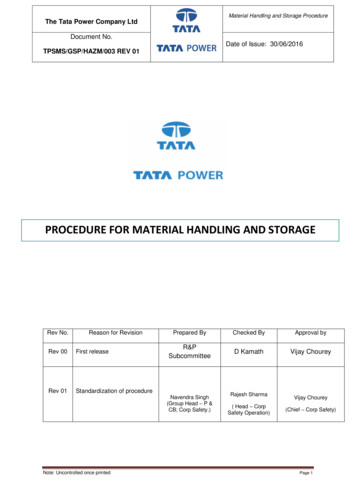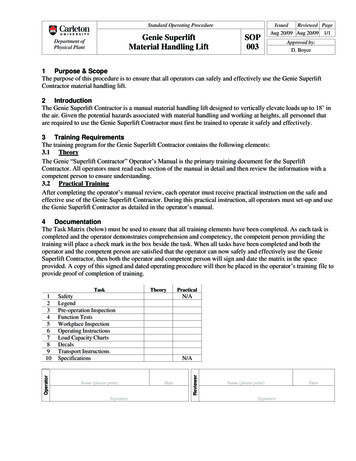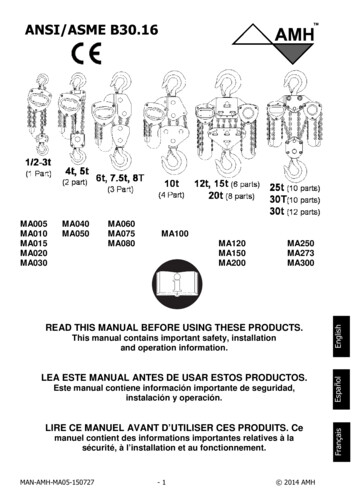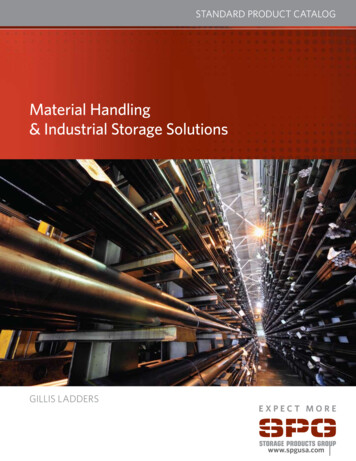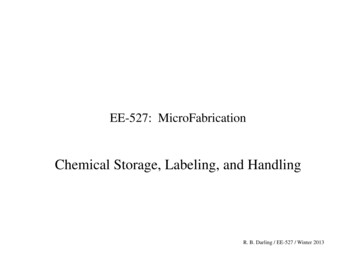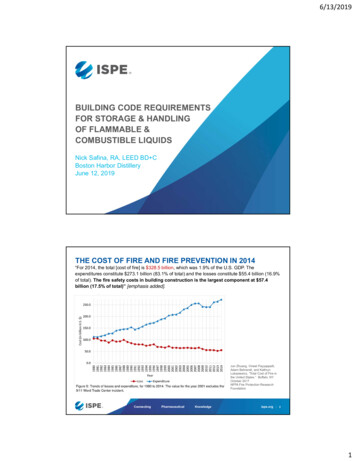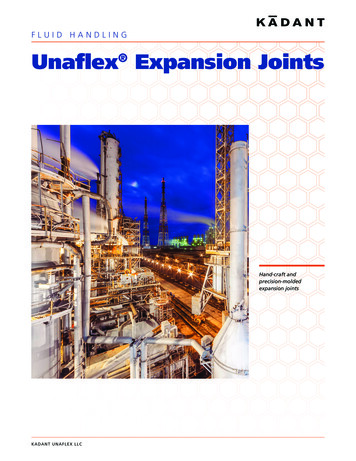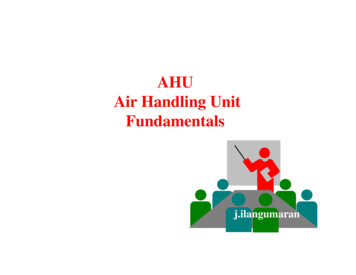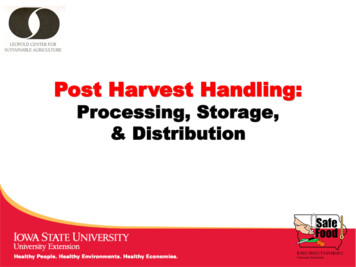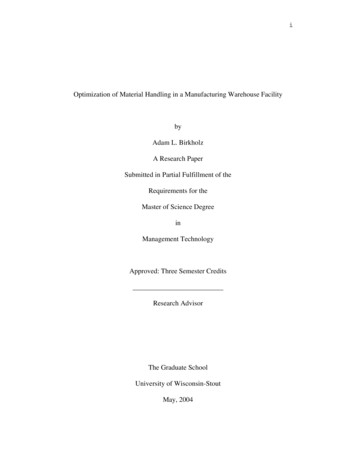
Transcription
iOptimization of Material Handling in a Manufacturing Warehouse FacilitybyAdam L. BirkholzA Research PaperSubmitted in Partial Fulfillment of theRequirements for theMaster of Science DegreeinManagement TechnologyApproved: Three Semester CreditsResearch AdvisorThe Graduate SchoolUniversity of Wisconsin-StoutMay, 2004
iiThe Graduate SchoolUniversity of Wisconsin StoutMenomonie, WI 54751ABSTRACTBirkholz Adam LOptimization of Material Handling in a Manufacturing Warehouse FacilityManagement TechnologyJames Keyes May 4, 200458 PagesAmerican Psychological Association, 5th editionCustomer satisfaction and organization competitiveness are contingent uponimplementing and improving existing logistics strategies. Thus, warehousing has becomean integral part of a comprehensive logistics strategy for organizations. Organizationsare continuing to streamline material movement in order to reduce customer shipmentlead times and minimize inventory storage requirements. Technological advances inenterprise resource planning and warehouse management systems have made theseefforts easier to achieve. However, the implementation of technology into warehousingrepresents a beginning from which current performance and improvement opportunitiesmust be constantly evaluated.
iiiThe following study will analyze the current utilization of a warehousemanagement system by a company in mid-western Wisconsin. The origins of logisticsand warehousing will be examined along with the impact of an automated system inwarehousing and its relation to enterprise resource planning. The research methodologyand subsequent results will be revealed with a discussion and recommendations based onthe findings.
ivACKNOWLEDGMENTSI would like to acknowledge and extend my gratitude to Jim Keyes of the UWStout College of Technology, Engineering and Management for his guidance and supportthroughout the evolution of this research paper.Also, I must thank SGI and the support of my manager Elizabeth Stavn forproviding me the opportunity to further my education.Most important, I would like to dedicate this work to my wife, Jennifer, family,and friends. I am eternally grateful for the tremendous support they have provided me.
vTABLE OF CONTENTS.PageABSTRACT. iiLIST OF TABLES. viiLIST OF FIGURES . viiiCHAPTER I: INTRODUCTION. 1Statement of the Problem. 1Purpose of the Study . 3Assumptions of the Study . 3Limitations of the Study. 4Methodology . 4CHAPTER II: LITERATURE REVIEW . 5Logistics. 5Warehousing . 10Warehouse Profiling . 12Warehouse Measuring and Benchmarking . 13Warehouse Management Systems . 16WMS Market . 17WMS Versus ERP. 18Warehouse Management System Projects . 19Assessment and Planning. 19Design . 22Implementation . 23Deployment. 25Common Mistakes . 26CHAPTER III: METHODOLOGY . 28Subject Selection and Description . 28
viData Collection Procedures. 29Data Analysis . 29Limitations . 30CHAPTER IV: RESULTS. 31Warehouse Physical Layout and Usage. 31Warehouse Inbound Logistics. 33Warehouse Outbound Logistics. 35CHAPTER V: DISCUSSION. 38Limitations . 38Conclusions. 38Recommendations. 40References. 43Appendix : Structured Query Language Code. 46
viiLIST OF TABLESTable 1. Warehouse Design Issues and Related Profiles (p. 12, 13).Table 2. World-Class Warehousing Practices (p. 14).Table 3. Warehouse Key Performance Indicators (p. 15).
viiiLIST OF FIGURESFigure 1. The Evolution of Logistics (p.7).Figure 2. Responsibilities of Logistics Executives (p. 8).Figure 3. Logistics’ Place in 1990s Business (p. 9).Figure 4. Warehouse utilization by row (p. 32).Figure 5. Inbound warehouse tasks and storage locator suggestion overrides from July2003 to March 2004 (p. 34).Figure 6. Outbound warehouse tasks and storage locator suggestion overrides from July2003 to March 2004 (p. 37).
1CHAPTER I: INTRODUCTIONWarehousing has retained its importance in today’s marketplace despite theemergence of supply chain management optimization techniques like lean manufacturingand just-in-time delivery. Traditionally, warehousing was regarded as a non-valueadding requirement in a logistics network. However, some warehouse and distributionfacilities are being asked to do much more than simply stock inventory. Manufacturingand warehouse facilities are merging together to create cohesive units that are flexible tothe changing requirements of the marketplace. Warehouse facilities are being asked toassemble, package, and ship inventory in some industries. The inventory could be raw,work in process, or finished goods.The material handling practices of warehouse and distribution facilities can have asignificant impact on overall profitability for an organization. Warehousing representsthe largest operational cost in the supply chains of organizations (Vega, 2004). It canrepresent 2 to 5 percent of the costs of sales of a corporation (Frazelle, 2002b, p. 3).Thus, an emphasis on warehouse optimization can help the bottom line of a company.The efficient use of space, equipment, and labor in the warehouse is an utmost concernfor organizations looking to trim distribution costs.Statement of the ProblemSilicon Graphics Incorporated (SGI) is a publicly traded company (New YorkStock Exchange symbol SGI) that engineers and manufactures high performancecomputers. The company also provides visualization and storage solutions. SGI wasfounded by former Stanford University professor Jim Clark in 1981. For over 20 years,the company has established a strong reputation for providing technology that is used in
2the following fields: manufacturing, energy, life sciences, media, and government anddefense. The products of SGI have been used in a variety of ways from creatingcomputer-generated imagery in the motion picture industry to studying global climatechanges and finding oil more efficiently (Silicon Graphics, 2004). SGI employsapproximately three thousand people around the world with headquarters in MountainView, CA. SGI is a company with annual revenues close to 1 billion dollars as in fiscalyear 2003. SGI has a manufacturing plant and warehouse facility located in ChippewaFalls, WI.SGI uses the 11i application suite by Oracle Corporation for its enterpriseresource planning (ERP) software needs. The ERP package includes software that helpsmanage customer orders, inventory, bill of materials, shop floor, costing, and accounting.SGI started using Oracle 11i in July of 2001. This system is used world-wide by SGIemployees. In July 2002, SGI installed an integrated warehouse management system(WMS) from Oracle. The computerized WMS represents a tool that facilitates theautomation and optimization of material handling processes. The material handlingprocesses include receipt, stocking, assembly, and shipment of inventory. It has helpedSGI improve inventory accuracy and facility usage, reduce labor costs, and enhance orderaccuracy. However, SGI is now looking to further optimize its material handlingprocesses with the assistance of tools provided within the Oracle WMS. Specifically,SGI is looking to optimize travel time of human and equipment resources within itsmanufacturing warehouse facility.
3Purpose of the StudyThe manufacturing warehouse facility of SGI is required to store more material inresponse to the expanding manufacturing facility demands. SGI logistics personnel areconcerned with adherence to world-class practices and standards in order to optimizeresources and minimize material handling. The purpose of this research is to addressthese two areas by making a series of material handling and inventory storagerecommendations for the manufacturing warehouse facility of SGI. This will be donewith data analysis of warehouse activity profiling and benchmarking. The significance ofthis research will lead to a recommendation of how items can be grouped and slotted aswell as how employees can efficiently travel around the warehouse for picking andputaway of inventory. The arrangement of warehouse tour routes will be incorporatedinto the inventory slotting research to minimize travel time for employees and equipment.Improvements to current picking and put away methodologies will be recommendedbased upon the data collected during this study.Assumptions of the StudyThis study assumes setups and data in the Oracle 11i database used by SGIpersonnel are accurate and properly maintained. It also assumes that there were notproblems with the Oracle product which would have caused data corruption during dataentry by material handlers.
4Limitations of the StudyResults and recommendations of this study are limited to this business case fromJuly 2003 to March 2004. Data gathered about warehousing and material handlingpractices came from the Oracle 11i application and database at SGI. Data within theapplication could have been corrupted by poor training or problems with the Oracleproduct. Poor training may have resulted in users not maintaining critical setups orperforming transactions in the system improperly. Problems with the Oracle productwould have caused data to be missed when using SQL to query the database.MethodologyThis research is an historical quantitative study of warehousing practices at theSGI manufacturing warehouse facility from July 2003 to March 2004. Internalbenchmarks will be determined for inbound and outbound inventory logistics movementat SGI. The following study will begin with a literature review of logistics, warehousing,and warehouse management systems. Conclusions and recommendations regardingoperational and Oracle software setup changes will be derived from the literature reviewand quantitative results.
5CHAPTER II: LITERATURE REVIEWLogisticsLogistics has become a term used to describe a variety of different functionswithin a corporation. There are many different definitions of what logistics encompasses.The Council of Logistics Management defines the term as “part of Supply ChainManagement that plans, implements, and controls the efficient, effective forward andreverse flow and storage of goods, services and related information between the point oforigin and the point of consumption in order to meet customers’ requirements” (Councilof Logist
concerned with adherence to world-class practices and standards in order to optimize resources and minimize material handling. The purpose of this research is to address these two areas by making a series of material handling and inventory storage recommendations for the manufacturing warehouse facility of SGI. This will be done
